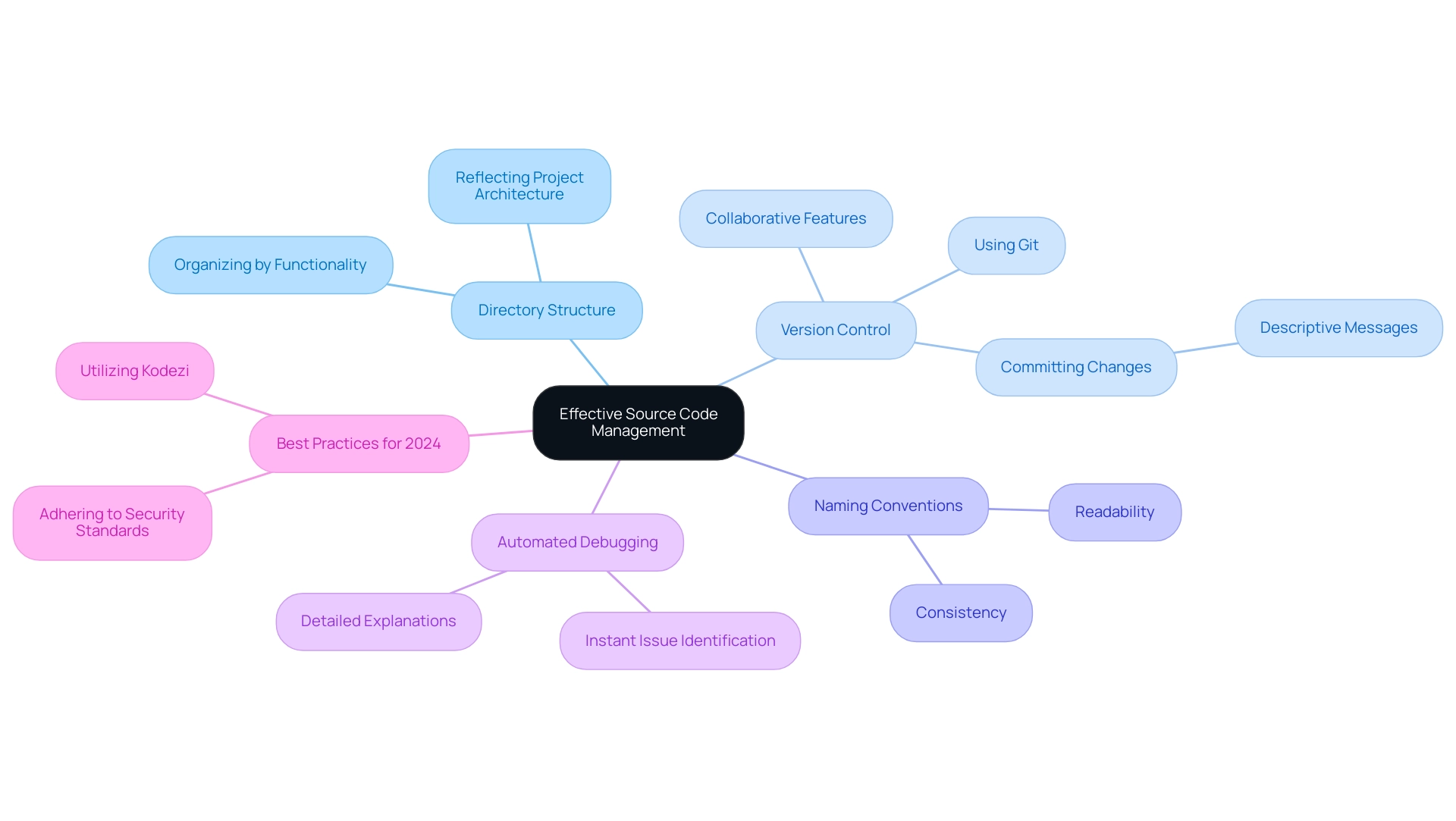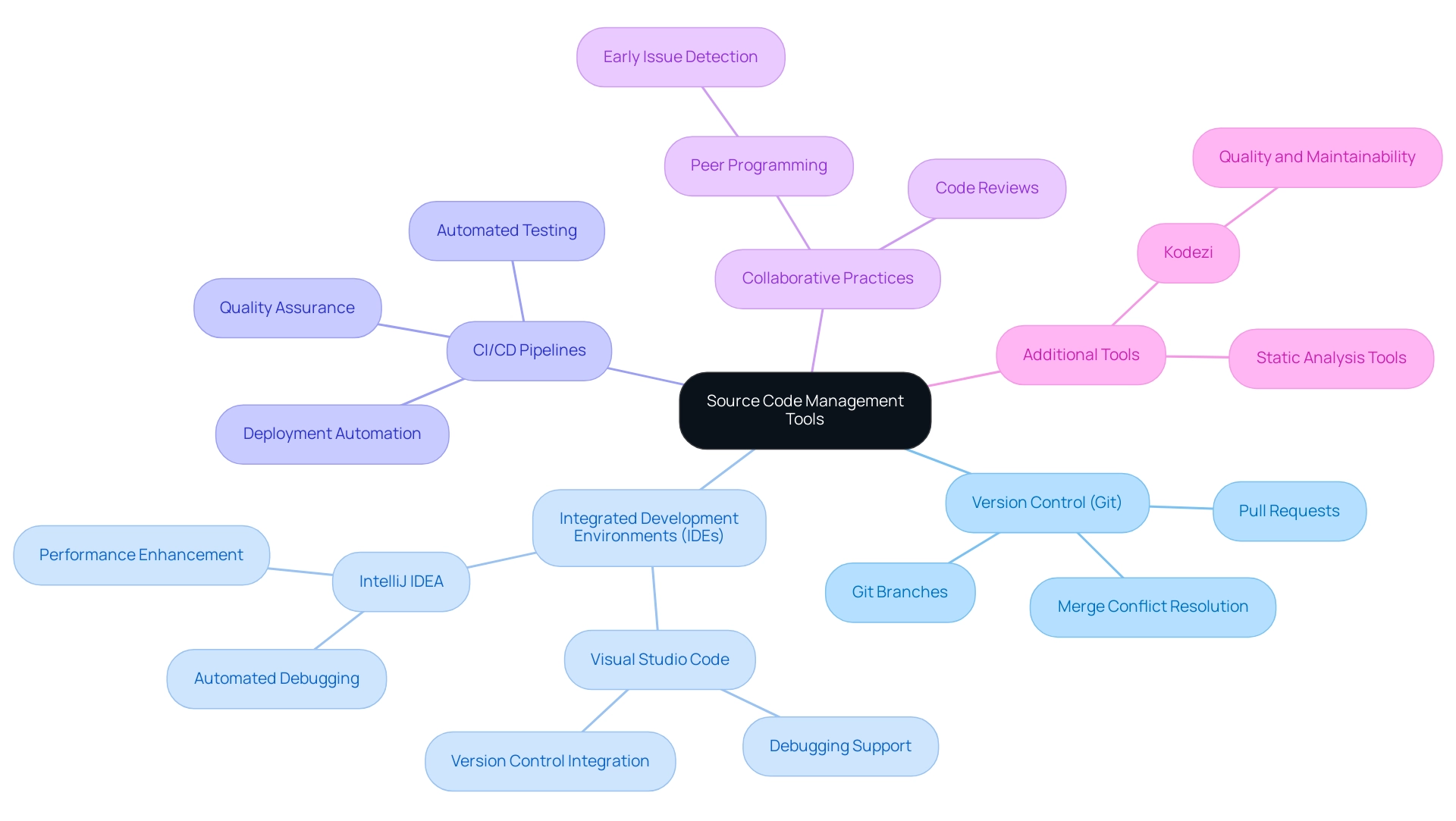Introduction
In the fast-evolving landscape of software development, mastering source code management is not just a technical necessity; it's a catalyst for productivity and efficiency. As teams grapple with increasing project complexities, the importance of a well-structured codebase cannot be overstated.
By implementing best practices such as:
- Modularization
- Version control
- Robust documentation
developers can streamline workflows and enhance collaboration. Tools like Kodezi are revolutionizing the way programmers approach coding challenges, offering automated solutions that not only improve code quality but also minimize time spent on debugging.
As organizations prepare for the future, embracing these strategies will pave the way for more secure, efficient, and effective software development processes.
Fundamentals of Effective Source Code Management
Effective management of source code files starts with a well-defined directory structure that reflects the project's architecture. Arranging source code files by functionality—such as dividing modules or features—enables programmers to quickly find and alter scripts, significantly improving productivity. Implementing consistent naming conventions for source code files and folders enhances the readability and comprehension of the project structure.
Leveraging version control systems (VCS) like Git is indispensable for managing source code files; it facilitates tracking changes, reverting to prior versions, and fostering seamless collaboration among team members. Moreover, committing changes regularly with descriptive messages not only aids in maintaining thorough project documentation but also enriches the historical context of the source code files. With the automated code debugging features, programmers can instantly identify and resolve codebase issues, gaining detailed explanations and insights into what went wrong and how it was rectified.
This ensures their codebase adheres to the latest security best practices and coding standards. The CLI acts as a Swiss-Army knife for programmers, enabling teams to auto-heal codebases in seconds and enhancing productivity by minimizing time wasted on pull requests. For instance, the CLI enables programmers to swiftly apply corrections across various files, enhancing workflows and minimizing the necessity for significant manual involvement.
As we look ahead to 2024, adhering to these best practices, alongside utilizing Kodezi, will enhance the efficiency of source management, aligning with the latest trends and ensuring that project workflows remain streamlined.

Practical Strategies for Managing Source Code Files
To enhance source management effectively, developers should prioritize modularization, breaking the codebase into smaller, manageable elements. By adopting this strategy, companies can reduce production time and costs by up to 20%. Modularization simplifies testing and debugging processes while significantly boosting collaboration among team members.
Kodezi CLI, with its 'AutoHeal' feature, further enhances this process by autonomously improving quality and fixing bugs before they reach production, ensuring a smoother workflow. A clear application architecture supports parallel creation of both general and business-oriented modules, keeping organized and maintainable structure. A consistent file structure that organizes files by purpose—such as models, views, and controllers—further streamlines management efforts.
Furthermore, utilizing branching strategies in version control, such as feature branching or trunk-based approaches, can improve collaboration and lessen integration challenges. Regular code reviews promote a culture of shared knowledge and continuous improvement. This aligns with expert opinions highlighting the necessity of management commitment in effective reuse programs, as noted by Hongyi Sun.
As evidenced by the case study on reusable architecture for Smart Energy Home Area Network (SE HAN) devices, the importance of a scalable architecture that adapts to rapid technological changes while supporting software reuse is vital. Recent articles have also emphasized that a well-defined file structure not only enhances team collaboration but can lead to improved efficiency and productivity in software development, further supported by the capabilities of the CLI. For those interested in getting started, the CLI provides a 5-minute quickstart and a demo to showcase its functionalities.
Ensuring Security in Source Code Management
To effectively safeguard source material, it is paramount that developers implement stringent access controls, allowing only authorized personnel to access sensitive files. In fact, 49% of IT and business leaders are implementing or upgrading network access control or zero trust network access, highlighting the critical need for robust access management. Regular audits and updates of access permissions are vital to mitigate potential risks and enhance security posture.
Secure coding practices, such as thorough input validation and robust error handling, significantly diminish vulnerabilities within the codebase. As noted by industry experts, 'commercial software risk is under-addressed,' emphasizing the urgency of addressing these vulnerabilities. Furthermore, integrating an AI-driven programming tool that functions as an autocorrect for programming can streamline this process by automatically analyzing bugs and rectifying scripts in real-time, thus enhancing productivity.
Unlike other tools that focus on autocompletion, this unique approach allows users to automatically debug and resolve coding issues effectively. Integrating automated security testing tools into the development pipeline enables early detection of security flaws, and this solution complements this by optimizing and generating comments for better code clarity. The platform currently supports over 30 programming languages and is designed to work with Visual Studio Code, with plans to expand to more Ideas in the future.
Keeping dependencies current and proactively monitoring for vulnerabilities in third-party libraries are essential practices for maintaining a secure codebase. In high-stakes industries like banking and healthcare, where the implementation of multi-factor authentication (MFA) and two-factor authentication (2FA) is becoming increasingly crucial as the number of IoT devices grows, leveraging tools like Kodezi not only enhances security but also ensures coding efficiency. The significance of these strategies is highlighted in the Asia-Pacific market's anticipated growth in the Physical Access and Identity Management sector by 2030; these strategies are not merely best practices but essential for future-proofing software against emerging threats.
Leveraging Tools for Enhanced Source Code Management
In the realm of software engineering, tools like Git are essential for the effective management of source code files. With 70% of programmers experiencing merge conflicts, leveraging Git features such as branches, merges, and pull requests is crucial for facilitating collaboration and efficiently managing changes. Furthermore, 75% of programmers find that peer programming or review helps catch and solve Git issues early, underscoring the importance of collaborative practices in development.
Integrated Development Environments (IDEs) such as Visual Studio Code and IntelliJ IDEA improve this process by offering built-in support for version control, streamlining management tasks. This platform complements these tools by providing automated debugging, allowing developers to quickly identify and resolve issues, enhance performance, and ensure security compliance. For instance, this tool can pinpoint performance bottlenecks and suggest enhancements, ensuring that the programming follows the latest security best practices.
As James Skemp notes, "if you prefer a hosted solution, you should check out Open Hub (formerly Ohloh.net). It is nice, but don't expect large statistics." With this tool, more than 1,000,000 programmers have experienced improved productivity through user-friendly features that simplify debugging and program reviews.
The implementation of CI/CD (Continuous Integration/Continuous Deployment) pipelines automates testing and deployment, ensuring that only high-quality code makes it to production. User testimonials highlight its impact, with many stating it acts like 'Grammarly for programmers,' drastically improving their efficiency and focus. The case study on cumulative culture theory illustrates how emphasizing collaboration can reshape developer productivity, leading to long-term success in software creation.
The use of additional tools for reviewing and static analysis, combined with Kodezi's capabilities, can further enhance quality and maintainability, reinforcing the significance of a strong toolset in achieving optimal results.

The Role of Documentation in Source Code Clarity
Effective documentation practices are pivotal in software development, starting with the creation of clear and concise comments within source code files. These comments illuminate complex logic and the rationale behind specific implementations in the source code files, serving not only current programmers but also future team members who will interact with them. In fact, 34.7% of software engineers consider poor documentation one of their biggest challenges, highlighting the critical need for effective practices.
Furthermore, maintaining external documentation—such as README files or project wikis—provides essential context, installation instructions, and usage examples that enhance overall understanding. It is equally important for programmers to document changes through commit messages that articulate the reasoning behind each modification. This approach not only fosters a culture of thorough documentation within the team but also ensures knowledge preservation, thereby facilitating smoother onboarding processes for new developers.
As Pavel Zverev aptly states, 'Documentation should keep pace with the processes or products and always represent their most actual current state.' A structured documentation process, as illustrated by case studies, underscores the importance of defining responsibilities for documentation creation and maintenance, ensuring consistent templates and periodic reviews to enhance accuracy and relevance. Additionally, when choosing a documentation solution, it is crucial to calculate the expected return on investment, ensuring that resources are effectively allocated to support documentation efforts.
Conclusion
Effective source code management is a cornerstone of successful software development, and adopting best practices is essential for enhancing productivity and collaboration among teams. By prioritizing modularization, implementing robust version control systems, and ensuring thorough documentation, developers can create a structured and efficient codebase that stands up to the complexities of modern projects. Tools like Kodezi play a pivotal role in this landscape, offering automated solutions that streamline workflows, improve code quality, and minimize debugging time.
The integration of Kodezi into the development process not only fosters a culture of shared knowledge through regular code reviews but also enhances security through automated code analysis and real-time debugging. As organizations prepare for the future, the emphasis on secure coding practices and effective access management will be critical in safeguarding sensitive information and maintaining the integrity of the codebase.
Ultimately, embracing these strategies and leveraging innovative tools like Kodezi will pave the way for a more efficient, collaborative, and secure software development environment. As the industry evolves, those who adapt and prioritize effective source code management will not only enhance their productivity but will also position themselves for long-term success in an increasingly competitive landscape.
Frequently Asked Questions
What is the importance of a well-defined directory structure in source code management?
A well-defined directory structure reflects the project's architecture and organizes source code files by functionality, allowing programmers to quickly find and modify scripts, which significantly improves productivity.
How do naming conventions affect source code files and folders?
Consistent naming conventions enhance the readability and comprehension of the project structure, making it easier for developers to navigate and understand the codebase.
Why are version control systems (VCS) like Git essential for managing source code?
VCS facilitates tracking changes, reverting to prior versions, and enables seamless collaboration among team members. Regularly committing changes with descriptive messages aids in maintaining thorough project documentation and enriches the historical context of the source code files.
How can automated code debugging features benefit programmers?
Automated code debugging helps programmers instantly identify and resolve issues in the codebase, providing detailed explanations of errors and how they were rectified, ensuring adherence to security best practices and coding standards.
What role does the command-line interface (CLI) play in source code management?
The CLI enhances productivity by allowing teams to quickly apply corrections across various files, minimizing manual involvement and time wasted on pull requests.
What is modularization, and how does it benefit source management?
Modularization involves breaking the codebase into smaller, manageable elements, which can reduce production time and costs by up to 20%, simplify testing and debugging processes, and boost collaboration among team members.
How does Kodezi CLI's 'AutoHeal' feature improve source management?
The 'AutoHeal' feature autonomously improves code quality and fixes bugs before they reach production, ensuring a smoother workflow.
What are some effective branching strategies in version control?
Feature branching and trunk-based approaches can improve collaboration and lessen integration challenges.
How do regular code reviews contribute to source code management?
Regular code reviews promote a culture of shared knowledge and continuous improvement among team members.
What is the significance of a scalable architecture in software development?
A scalable architecture adapts to rapid technological changes and supports software reuse, which is vital for effective source management and collaboration.
Where can developers find resources to get started with Kodezi CLI?
Developers can access a 5-minute quickstart guide and a demo to showcase the functionalities of Kodezi CLI.




